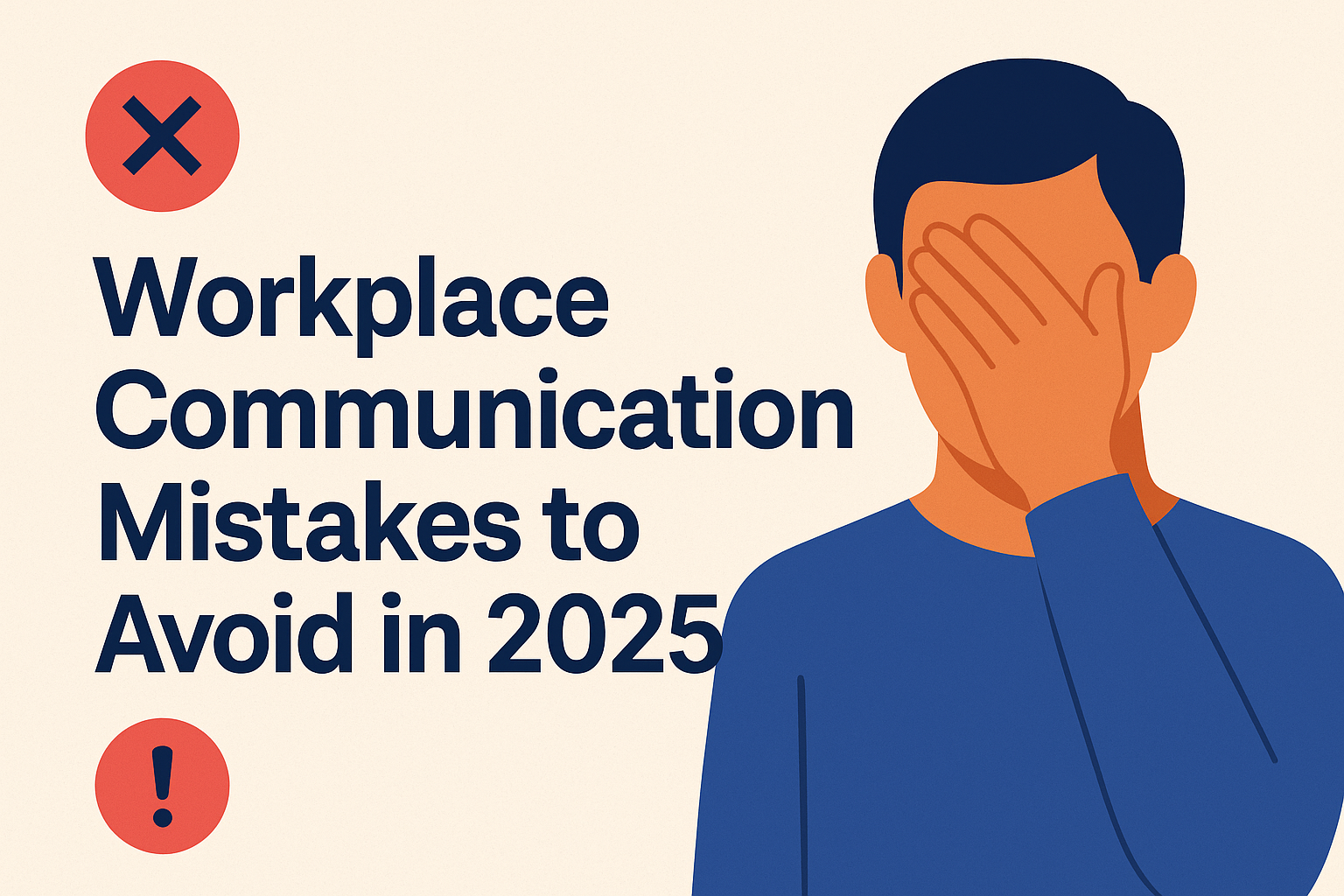Workplace Communication Mistakes to Avoid in 2025

Whether you're working in an office, remotely, or in a hybrid model, strong communication is the backbone of productivity, collaboration, and culture. Yet in 2025, with communication channels multiplying (Slack, Teams, Zoom, async video, AI assistants, etc.), it’s easier than ever to make communication mistakes that impact how you're perceived—and how effectively you get work done.
Poor communication doesn’t just cause confusion—it can cost opportunities, erode trust, and hold back careers.
In this blog, we’ll cover:
- The top communication mistakes professionals are making in 2025
- What’s changed post-pandemic and in hybrid environments
- How to avoid digital misfires and nonverbal blunders
- Tools to improve clarity and tone
- A real case study of career impact
Let’s help you communicate with more confidence, clarity, and impact.
1. Mistake: Assuming Everyone Interprets Tone the Same Way
In remote-first workplaces, tone can be misread easily.
Examples:
- "Sure." (sounds annoyed?)
- "Fine." (passive-aggressive?)
- "Got it." (dismissive?)
✅ Instead of brief replies, add warmth and clarity:
- “Sounds great—thanks!”
- “Got it, appreciate the update.”
- “Will review and come back with thoughts!”
Tip: Emojis and exclamation marks are not unprofessional if used with balance. They can prevent misinterpretation.
2. Mistake: Sending Long Paragraphs in Slack or Teams
In fast-paced digital workspaces, long messages get skimmed or skipped.
✅ Use formatting to make messages scannable:
- Line breaks
- Bullet points
- TL;DR summaries
Example:
TL;DR: Client wants the Q2 draft by Friday. Here’s the outline we discussed:Campaign goalsDraft timelineFeedback loop
Tool: Slack's Block Kit or formatting features can help structure your messages.
3. Mistake: Overusing Jargon and Buzzwords
“Let’s circle back with a synergy-led strategy that adds value and leverages agile frameworks.”
😖 Translation: No one knows what you’re actually saying.
✅ Use plain, direct language. Clarity wins over cleverness.
Instead of: “We need to ideate cross-functional blueprints.”
Say: “Let’s brainstorm ideas that involve sales and marketing.”
Pro tip: If ChatGPT can’t explain your message to a 10-year-old, revise it.
4. Mistake: Defaulting to Email When Real-Time Would Work Better
Email is great for records—but terrible for urgent feedback or brainstorming.
✅ Use the right channel for the right message:
- Email – Formal updates, documentation, external communication
- Slack/Teams – Quick updates, clarifications
- Video/Voice call – Nuanced conversations, feedback, conflict resolution
Tool: Use Loom for async video walkthroughs that are faster than typing long emails.
5. Mistake: Speaking Without Listening
Many professionals focus on what to say, but not on how to listen.
✅ In meetings:
- Don’t interrupt (even virtually)
- Paraphrase before responding: “So what I’m hearing is...”
- Ask follow-up questions
Read more: Mastering Feedback: Giving It, Taking It, Using It
6. Mistake: Multitasking During Zoom or In-Person Meetings
Yes, people can tell when you're distracted.
✅ Show presence:
- Turn on your camera in smaller meetings
- Take notes visibly if possible
- Avoid checking emails or typing during critical conversations
Quote: "If you wouldn’t do it in an in-person meeting, don’t do it in a virtual one." – Harvard Business Review
7. Mistake: Failing to Recap or Confirm Next Steps
Conversations (especially virtual ones) lose impact without clear action.
✅ Always end meetings or threads with:
- Summary of decisions
- Next steps
- Who owns what, by when
Example:
Action Items:Jordan: Send updated deck by ThursdayPriya: Draft follow-up email to clientNext review: Friday 2 PM
Tool: Fellow.app for collaborative meeting agendas and notes.
8. Mistake: Avoiding Difficult Conversations
Conflict doesn’t go away—it compounds.
✅ Address issues directly, respectfully, and early.
Use the SBI model:
- Situation: “In today’s team call...”
- Behavior: “...you interrupted while I was presenting.”
- Impact: “It threw me off and felt dismissive.”
Read more: How to Handle a Difficult Boss (and When to Escalate)
9. Mistake: Over-Relying on Written Messages for Emotional Topics
Don’t break bad news, give tough feedback, or discuss performance concerns over Slack or email.
✅ Have these conversations:
- Face-to-face
- Over video call
- With tone and body language in play
Tip: Follow up with a written summary—but don’t let it replace the human conversation.
10. Mistake: Neglecting Communication With Remote Peers
Out of sight shouldn't mean out of mind.
✅ Set recurring check-ins with remote teammates
✅ Use visibility tools (status updates, dashboards)
✅ Celebrate their wins in team channels
Tool: Donut – Automates virtual intros and check-ins for distributed teams
Case Study: How Carlos Improved Team Communication and Got Promoted
Background: Carlos, a project manager in a hybrid team across the U.S. and UAE, was getting feedback that stakeholders felt "out of the loop."
What he changed:
- Moved project updates from monthly emails to biweekly Loom videos
- Added Slack summaries with bullet-point recaps
- Started meetings with a 2-minute context setup, and ended with assigned action items
- Created a shared Notion board for timelines and deliverables
Results:
- Cross-team alignment improved dramatically
- Senior leadership recognized his communication systems
- Promoted to a global team lead in under a year
Carlos’s takeaway: "I realized communication wasn’t just part of my job—it was the job."
11. Tools to Strengthen Workplace Communication in 2025
✅ Grammarly – Tone checker, writing clarity
✅ Loom – Async video messaging
✅ [Slack / Microsoft Teams] – Real-time conversations
✅ [Notion / Confluence] – Centralized documentation
✅ Otter.ai – Transcripts of meetings for searchable reference
Final Thoughts: Communication Is a Leadership Skill—No Matter Your Title
In 2025, the way you communicate is as important as what you communicate.
Avoiding small missteps—like tone confusion, long Slack rants, or vague follow-ups—can significantly improve:
- Team trust
- Project efficiency
- Your personal reputation
Communicate to connect, not just transmit.
Mastering modern workplace communication isn’t about being perfect—it’s about being present, clear, and thoughtful.

